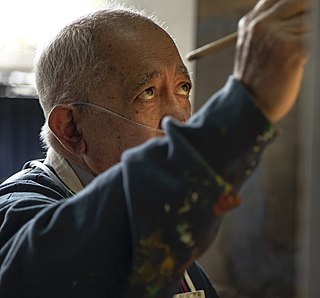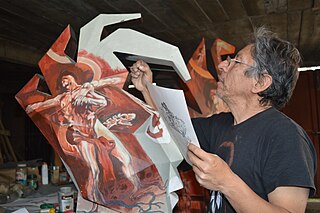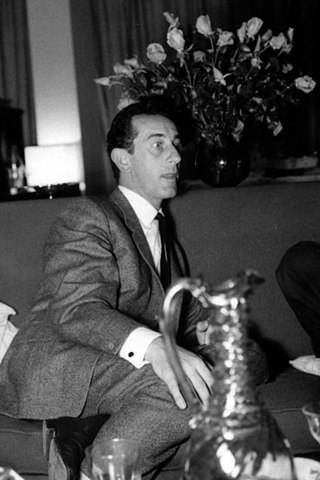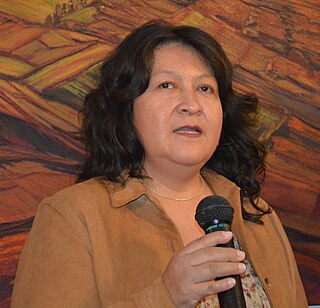Related Research Articles
Carlos Orozco Romero was a Mexican cartoonist and painter who co-founded several cultural institutions in Mexico, including the Escuela Nacional de Pintura, Escultura y Grabado "La Esmeralda". His work was recognized with membership in the Academia de Artes and the Salón de la Plástica Mexicana, and in 1980, with Mexico's Premio Nacional de Arte.

Gilberto Aceves Navarro was a Mexican painter and sculptor and a professor at the Escuela Nacional de Artes Plásticas and Academy of San Carlos. There have been more than two hundred individual exhibits of his work, with his murals found in Mexico, Japan and the United States. He received numerous awards for his work including grants as a Creador Artístico of the Sistema Nacional de Creadores de Arte, Premio Nacional de Ciencias y Artes and Bellas Artes Medal from the Instituto Nacional de Bellas Artes.
Cordelia Urueta Sierra was a Mexican artist best known for her use of color and abstraction but still retaining frequent reference to the human form. She was born into an intellectual and artistic family, related to painter David Alfaro Siqueiros and educator Justo Sierra. Her father, writer and diplomat Jesús Urueta Siqueiros, died when she was eleven with her health becoming quite poor afterwards. She began drawing when she was a child, mostly portraits with Dr. Atl noticing her talent. She did not have extensive formal training but became an art teacher, meeting a number of contemporary Mexican artists, including her husband Gustavo Montoya. After a time in Paris and New York, she returned to Mexico permanently in 1950 to dedicate herself to painting, exhibiting extensively in Mexico and abroad mostly in the 1950s and 1960s. She was offered the Premio Nacional de Arte but rejected it.

María Luisa Reid is a Mexican artist from Zacatepec in the state of Morelos. She is a member of the Salón de la Plástica Mexicana.

Mauricio García Vega is a Mexican painter whose work has been recognized by various awards and membership in the Salón de la Plástica Mexicana. His work is mostly focused on urban landscapes, often with dark themes and a chaotic feel. He works both alone and with his brother Antonio García Vega. He lives and works in the Mexico City suburb of Ciudad Nezahualcóyotl.

Antonio García Vega is a Mexican artist and member of the Salón de la Plástica Mexicana. He began exhibiting his work while still in school in the early 1970s and continues to do so, often working with his brother Mauricio García Vega. He works in mixed media to paint various forms of expression. His early work was mostly fantastic, with elements of eroticism but his later work has been darker as a means of expressing his own feelings and moods. His work has mostly been exhibited in Mexico, often in conjunction with other artists including a 2010 exhibition with his brother at various venues.

Deyanira África González Melo is a Mexican sculptor who generally works in ceramics, depicting elements of the human form, especially the torso, generally with mutilations and other disturbing elements to dispute the otherwise traditional and sensual depictions of the human body. She has exhibited her work since studying at the Escuela Nacional de Artes Plásticas (ENAP) in Mexico as well as in Europe and the Caribbean. Her work has received recognition in Mexico and abroad, and is a member of the Salón de la Plástica Mexicana.
Rosa Castillo Santiago was a Mexican sculptor, and founding member of the Salón de la Plástica Mexicana.
Eliana Menassé is a Mexican painter and member of the Salón de la Plástica Mexicana, an honor society for Mexican artists
Olga Dondé was a Mexican artist involved in various fields but best known her still life pieces. She was a self-taught painter, who worked for two years until she decided to enter works in a show in 1968. From then she had about 100 showings of her work, including more than forty individual exhibitions in Mexico, the United States, South Americana and Europe. She also founded artistic organizations, an art gallery and a publishing house. Dondé’s work was recognized by admission in the Salón de la Plástica Mexicana, among other honors and her work continues to be shown and honored after her death.
Roberto Donis was a Mexican painter and art teacher. He began studying art at the Escuela Nacional de Pintura, Escultura y Grabado "La Esmeralda", but unsatisfied with the instruction, helped organize a student strike. It was unsuccessful and rather than return to school, he decided to go to Morelia to teach. Donis’ art career consisted of exhibitions both in Mexico and abroad, including an important exhibition at the Museo de Arte Moderno in Mexico City and accepted as a regular with the prestigious Galería de Arte Mexicano. His teaching career included directorship at the Universidad Autónoma Benito Juárez as well as helping to found the Taller de Artes Plásticas Rufino Tamayo in the city of Oaxaca. He received several recognitions for his work, including membership in the Salón de la Plástica Mexicana.
Leonel Maciel is a Mexican artist, member of the Salón de la Plástica Mexicana, from the coast of the state of Guerrero. Although from a rural area and farming family, he studied art at the Escuela Nacional de Pintura, Escultura y Grabado "La Esmeralda" and has traveled extensively in Europe and Asia, which has influenced his work. His art has changed styles from generally contains multiple elements and saturated colors.
Tomás Parrá is a Mexican artist, cultural promoter and museum curator. His work has been noted with membership into Mexico Sistema Nacional de Creadores de Arte.

Antonio Peláez (1921–1994) was a Mexican artist of Spanish origin, who began his career in portraits but in the 1950s shifted to abstract art, concerned with texture, color and the use of space. His work was recognized by a retrospective at the Palacio de Bellas Artes, membership in the Salón de la Plástica Mexicana and a tribute by the Universidad Autónoma Metropolitana after his death.

Herlinda Sánchez Laurel was a Mexican artist and art professor at the Universidad Nacional Autónoma de México. Her career has been recognized by membership in the Salón de la Plástica Mexicana, and awards from the state of Baja California, the Palacio de Bellas Artes and the International Coordination of Women in Art among others.

Naomi Siegmann was an American artist who developed her career in Mexico, and was noted for her depiction of everyday objects outside their normal contexts. She began her career after she moved to Mexico with her family, learning to carve wood. She worked in this medium for about twenty years, before moving on to other materials, including recycled ones, in part due to her concerns for the environment. During her career, she had solo exhibits in Mexico and the United States, with participation in collective exhibits in these countries and Europe. She has been commissioned to create monumental works in Mexico and the United States. Her work has been recognized through membership in the Salón de la Plástica Mexicana.

Julia López is a Mexican painter whose works depict her childhood home in the Costa Chica region of Guerrero state. She was born in a small farming village but left early for Acapulco and Mexico City to find a better life. In the capital, she was hired as a model for artists at the Escuela Nacional de Pintura, Escultura y Grabado "La Esmeralda" and as such became part of the circle of notable artists of that time. Their influenced encouraged her to draw and paint, with Carlos Orozco Romero discouraging her from formal instruction as to not destroy her style. She began exhibiting in 1958 and since then has exhibited individually and collectively in Mexico, the United States and Europe. Her work has been recognized with awards and membership in the Salón de la Plástica Mexicana.
Lourdes Alaniz is a Mexican painter and graphic artist whose work has been recognized with exhibition in Mexico’s Salón de la Plástica Mexicana.
Yolanda Cabrera is a Mexican artist who was a graphic designer for twenty years before turning to the fine arts. Her work shows influence from her former profession along with the use of personal symbolism and experimentation in both materials and techniques. Cabrera’s work has been shown regularly in Mexico City and other parts of the country and has been recognized by the Salón de la Plástica Mexicana.

Angelica Carrasco is a Mexican graphic artist who is a pioneer of large scale printmaking in the country. Her work often is related to violence and classified as “abstract neo-expressionism.” Much of her career has been dedicated to teaching and the promotion of the arts, especially the graphic arts and has been recognized with membership in the Salón de la Plástica Mexicana and the Sistema Nacional de Creadores de Arte.
References
- 1 2 3 4 5 6 7 8 9 Mujeres del Salón de la Plástica Mexicana. Vol. 1. Mexico City: CONACULTA/INBA. 2014. pp. 122–123. ISBN 978-607-605-255-6.
- 1 2 3 4 5 6 7 "Flor Minor". Mexico City: Galería Arte-Contemporáneo. Archived from the original on March 4, 2016. Retrieved September 18, 2015.
- 1 2 "Arquitecturas de lo íntimo. Flor Minor". Mexico City: Museo Dolores Olmedo. 2014. Archived from the original on February 11, 2015. Retrieved September 18, 2015.
- 1 2 3 Dafne Cruz Porchini (May 2000). "Flor Minor:Obra gráfica". Difusión. UNAM . Retrieved September 18, 2015.
- 1 2 Fabiola Palapa Quijas (May 17, 2014). "Flor Minor exhibe sus arquitecturas de lo íntimo". La Jornada. Mexico City. p. 4. Retrieved September 18, 2015.